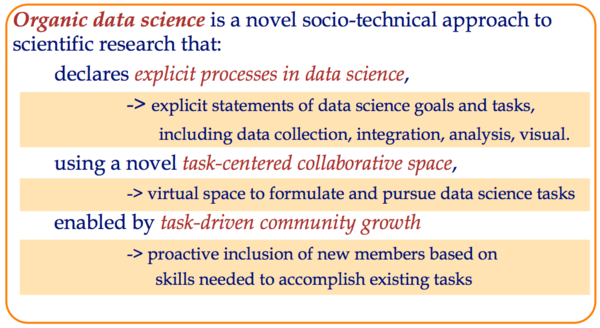Difference between revisions of "Framework Design"
(Added PropertyValue: Expertise = Computer Science) |
(Added PropertyValue: SubTask = Comparison with Other Collaborative Platforms) |
||
| Line 48: | Line 48: | ||
Participant=Felix| | Participant=Felix| | ||
Participant=Yolanda_Gil| | Participant=Yolanda_Gil| | ||
| + | SubTask=Comparison_with_Other_Collaborative_Platforms| | ||
SubTask=New_Features_Discussion}} | SubTask=New_Features_Discussion}} | ||
Revision as of 20:19, 2 June 2014
Contents
Designing the Platform for Organic Data Science
The Organic Data Science platform represents the technical approach in Organic Data Science. Our goal is to develop a social computing system that supports collaborative science.
The Organic Data Science platform is unique in its emphasis on supporting scientific tasks and processes. We are developing a detailed comparison with other frameworks for collaboration, see below.
The platform will be under development during the life of the project. Any comments and contributions are very welcome!
We draw from principles for social collaboration, explained below, to guide the design of the platform. The implementation builds on a Semantic Wiki platform.
Comparison with Other Collaborative Platforms
STATUS: This section is still under development
Social Collaboration Principles that Guide the Design of the Organic Data Science Platform
STATUS: This section is still under development
Starting Communities
- Create mechanisms to match people to activities
Partly addressed by: Task Representation - Highlight more active tasks
- Inactive tasks should have „expected active times“
Encouraging Contributions through Motivation
- Make it easy to see and track needed contributions
Addressed by: Task Representation, Explorer Navigation, Worklist, Task Alert, Timeline, User TrackingPartly addressed by: Progress Tracking - Ask specific people on tasks of interest to them
Addressed by: User Tracking - Simple tasks with challenging goals are easier to comply with Addressed by: Task Representation
- Specify deadlines for tasks, while leaving people in control
Partly addressed by: Explorer Navigation - Give frequent feedback specific to the goals
- Requests coming form leaders lead to more contributions
- Publicize that others have complied with request Partly addressed by: Worklist
- People are more willing to contribute: 1) when group is small, 2) when commited to the group, 3) when their contributions are unique
Encouraging Commitment
- Cluster members to help them identify with the community
Addressed by: User TrackingPartly addressed by: Explorer Navigation - Give subgroups a name and a taglinePartly addressed by: Task RepresentationExplorer Navigation
- Put subgroups in the context of a larger group Addressed by: Explorer NavigationPartly addressed by: Task Representation, Worklist
- Interdependent tasks increase commitment and reduce conflict
Addressed by: TimelinePartly addressed by: Task Representation, Worklist
